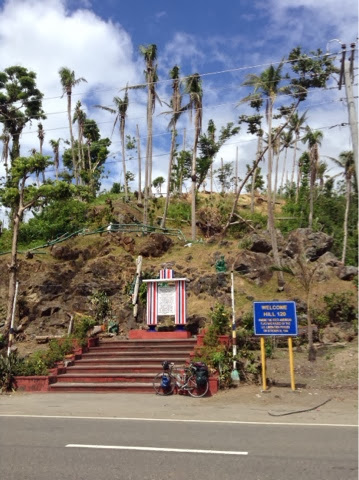I cycled past the devastation wrought by typhoon Yolanda, one of the fiercest ever. It swept through on the morning of Nov. 6, and was on its way in just a couple of hours, leaving more than 6,000 dead and tens of thousands homeless.
There was rubble everywhere, piled and still strewn, sometimes as far as the eye could see. For miles and miles I felt like I was cycling through a refugee camp. Though there was no tent city, official white UN tents for some of the displaced were mixed in with the resurrected shanties most lived in.
But there was bustle and activity everywhere. The strongest gloom came from what coconut trees hadn't been knocked down. All had been denuded of their coconuts and many had had their tops ripped off. Those fronds that remained were wilted or in a pained state of disarray less recovered from the catastrophe inflicted upon them than their human counterparts. Rubble is not such an uncommon site, seen in junkyards and slums, but these forlorn trees put a heart-rending exclamation point on the great upheaval inflicted by Yolanda.
As I entered Tacloban, the largest city on Leyte with more than a quarter million people, a large ship still lay washed up on shore, just encroaching upon the road.
A little ways beyond a mob of victims were gathered outside an office seeking assistance.
As I closed in on the central district of the city, there was minimal evidence of damage. Its buildings were constructed to withstand storms. Though a ten-foot tidal wave flooded the city, there were only six deaths in the city itself. All the rest came in the outlying areas from people living in not very substantial structures.
When I found the shop of Dave, the cyclist I had met on the road the day before, his wife showed me footage she had shot of the storm on her phone from their third floor apartment above the shop. It showed the water surging through the streets and the wind whipping power lines and trees. Everyone I talked to called it by far their most terrifying experience. Just an hour before the storm hit around 6:30 a.m., the sky was clear and the wind was calm. And then the storm came roaring through, but just for a couple of hours.
I arrived in Tacloban late in the afternoon and checked on a few hotels on the way to Dave's shop. There were so many relief workers in town, there wasn't a vacancy to be found, at least among the budget hotels. Dave thought he might be able to find one. We biked around together but had no more luck than I had on my own. A friend of his said I could camp at a friend's resort outside of Palo, less than ten miles away and where I was headed to visit the monument commemorating Gen. MacArthur's return to the Philippines in 1944 to take on the Japanese, who had forced him and his troops out of the country two years before. He vowed at the time that he would return.
All around the monument were scalped and wilted palm trees, but there was no damage to it.
Behind it is the Bay of Leyte, where one of the greatest naval battles in history was fought. Janina's father was part of it. His ship the SS Ladd http://en.wikipedia.org/wiki/SS_William_S._Ladd was sunk by a Japanese kamikaze and rests at the bottom of the bay. As the ship sank, he was sent back to it by his commanding officer to rescue others, as he was known to be one of the better swimmers on its Merchant Marine crew.
Ten miles down the coast from MacArthur's landing site is the Iwo Jima of the Philippines, where the first America flag was planted 42 minutes after the troops landed on a high spot known as Hill 120 with its palm trees all in a woeful state.
The main plaque fully honors the Americans.
Further down the coast MacArthur is honored with a town named for him.
By the time I reached Abuyog I had left the zone that received the brunt of Yolanda's fury. I found the first WIFI in the fifty miles since Tacloban. The man with the WIFI also told me about a better road than what I intended to take that would save me twenty-five miles to the ferry over to Bohol. It included a thousand foot climb over the island's mountain ridge to its opposite shore. At the town on Baybay, pronounced bye-bye, I met a cyclist who told me about a resort I could camp at six miles down the road. The "resort" had no beach, just a swimming pool, but it had a patch of grass for my tent, all that I needed. The owners didn't speak much English and didn't realize I intended to camp until I started setting up my tent. Then they asked for one hundred pesos more than the twenty peso charge to use the pool, still a great bargain.












No comments:
Post a Comment